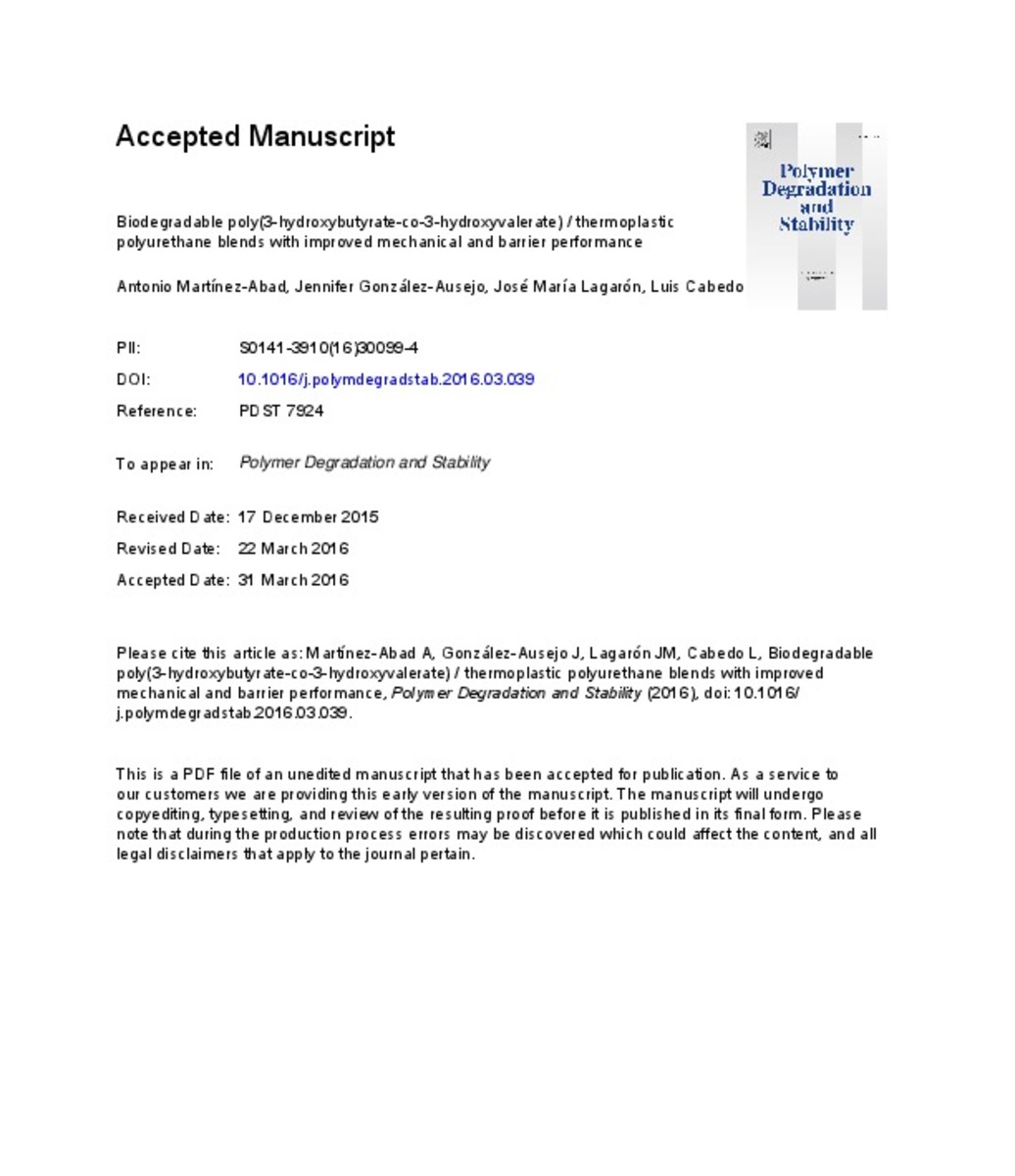Mostrar el registro sencillo del ítem
Biodegradable poly(3-hydroxybutyrate-co-3-hydroxyvalerate)/thermoplastic polyurethane blends with improved mechanical and barrier performance
| dc.contributor.author | Martínez Abad, Antonio | |
| dc.contributor.author | González Ausejo, Jennifer | |
| dc.contributor.author | LAGARON, Jose | |
| dc.contributor.author | Cabedo, Luis | |
| dc.date.accessioned | 2016-10-19T09:47:54Z | |
| dc.date.available | 2016-10-19T09:47:54Z | |
| dc.date.issued | 2016-10 | |
| dc.identifier.citation | MARTÍNEZ-ABAD, Antonio, et al. Biodegradable poly (3-hydroxybutyrate-co-3-hydroxyvalerate)/thermoplastic polyurethane blends with improved mechanical and barrier performance. Polymer Degradation and Stability, 2016. | ca_CA |
| dc.identifier.uri | http://hdl.handle.net/10234/163659 | |
| dc.description | Papers presented at 5th International Conference on Bio-based and Biodegradable Polymers (BIOPOL-2015) | ca_CA |
| dc.description.abstract | Poly(3-hydroxybutyrate-co-3-hydroxyvalerate) (PHBV) polymers pose a green alternative to fossil-fuel derived polymers, as they exhibit good biocompatibility, biodegradability and outstanding barrier performance compared to other biopolyesters. However, their excessive brittleness has not yet been overcome without compromising barrier performance. In this work, a native ester-based thermoplastic polyurethane (TPU) not stabilised against hydrolysis, has been thoroughly assessed for the first time as an additive in melt blends with PHBV. Phase segregation in scanning electron microscopy (SEM) confirmed the immiscibility of the two polymers, however a degree of interaction has been found. Wide-angle X-ray scattering and differential scanning calorimetry revealed no major effect of the TPU on the crystallinity of the PHBV phase. The onset and kinetics of thermal degradation was not altered by the presence of the TPU up to 50 wt% content. Blends with increasing TPU contents showed a gradual decrease in the modulus of elasticity and tensile strength, while a substantial increase in elongation at break has been found for contents of TPU above 20 wt%, which resulted an improvement in the overall toughness of the blends. The excellent barrier performance of the PHBV against water vapour and aroma compounds was shown to be unaffected by TPU loads of ≤30 wt%. Full decomposition of neat PHBV and PHBV/TPU blends below 50 wt% TPU content was achieved after 40 days according to biodisintegration standards (ISO 20200). The study puts forward the potential use of TPU to improve the mechanical performance of these natural biopolyesters without compromising the barrier properties or the biodisintegratibility of the melt blends. | ca_CA |
| dc.description.sponsorShip | The authors wish to thank the European project ECOBIOCAP and the Ministry of Economy and Competitiveness under project MAT2012-38947-C02 for financial support. Jennifer Gonzalez-Ausejo gratefully acknowledges financial support under grant “Pla de promoció de la investigació en la Universitat Jaume I” Predoc/2012/32. | ca_CA |
| dc.format.extent | 9 p. | ca_CA |
| dc.format.mimetype | application/pdf | ca_CA |
| dc.language.iso | eng | ca_CA |
| dc.publisher | Elsevier | ca_CA |
| dc.relation.isPartOf | Polymer Degradation and Stability Volume 132, October 2016 | ca_CA |
| dc.rights | © 2016 Elsevier Ltd. All rights reserved. | ca_CA |
| dc.rights.uri | http://rightsstatements.org/vocab/InC/1.0/ | * |
| dc.subject | PHBV | ca_CA |
| dc.subject | TPU | ca_CA |
| dc.subject | biodisintegration | ca_CA |
| dc.subject | melt blending | ca_CA |
| dc.subject | biodegradable polymers | ca_CA |
| dc.title | Biodegradable poly(3-hydroxybutyrate-co-3-hydroxyvalerate)/thermoplastic polyurethane blends with improved mechanical and barrier performance | ca_CA |
| dc.type | info:eu-repo/semantics/article | ca_CA |
| dc.identifier.doi | http://dx.doi.org/10.1016/j.polymdegradstab.2016.03.039 | |
| dc.rights.accessRights | info:eu-repo/semantics/openAccess | ca_CA |
| dc.relation.publisherVersion | http://www.sciencedirect.com/science/article/pii/S0141391016300994 | ca_CA |
Ficheros en el ítem
Este ítem aparece en la(s) siguiente(s) colección(ones)
-
ESID_Articles [472]







